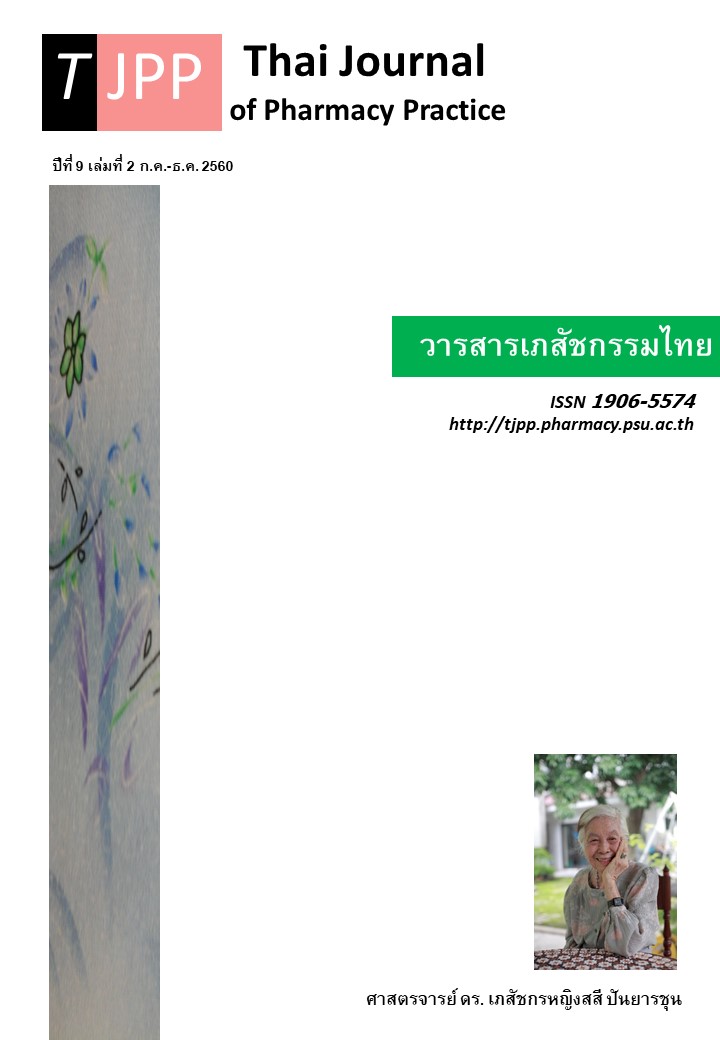ผลการจัดการเรียนรู้แบบห้องเรียนกลับด้านในหัวข้อเภสัชวิทยาของ ยารักษาโรคเบาหวานในนิสิตเภสัชศาสตร์ของมหาวิทยาลัยมหาสารคาม
Main Article Content
บทคัดย่อ
วัตถุประสงค์: เพื่อศึกษาผลการจัดการเรียนรู้แบบห้องเรียนกลับด้าน (flipped classroom) ในหัวข้อเภสัชวิทยาของยารักษาโรคเบาหวาน ในนิสิตเภสัชศาสตร์ชั้นปีที่ 3 ของคณะเภสัชศาสตร์ มหาวิทยาลัยมหาสารคาม วิธีการ: นิสิตศึกษาเนื้อหาบทเรียน (ไฟล์ชนิด voice-over PowerPoint) ด้วยตนเองก่อนเข้าชั้นเรียน กิจกรรมในชั้นเรียน คือ การแก้ปัญหาจากกรณีศึกษา นิสิตได้รับการประเมินความรู้และความพร้อมในการเรียนรู้แบบนำตนเองก่อนและหลังการเรียน พร้อมกับให้ความคิดเห็นต่อการเรียนรู้แบบห้องเรียนกลับด้าน ผลการวิจัย: หลังการเรียนรู้นิสิตมีคะแนนความรู้ที่เพิ่มสูงขึ้นจากก่อนเรียนอย่างมีนัยสำคัญทางสถิติ (p<0.001) เมื่อทดสอบความคงทนของการเรียนรู้หลังการเรียนรู้ 1 เดือนพบว่า คะแนนความรู้ลดลงจากระดับที่วัดหลังเรียนทันที แต่ยังคงสูงกว่าระดับก่อนเรียนอย่างมีนัยสำคัญทางสถิติ (p<0.001) นิสิตมีผลสัมฤทธิ์ทางการเรียนเฉลี่ยจากการสอบกลางภาคในหัวข้อนี้คิดเป็นร้อยละ 74.91±12.13 นิสิตส่วนใหญ่เห็นด้วยกับการจัดการเรียนรู้รูปแบบนี้ นอกจากนี้หลังการเรียนรู้นิสิตมีคะแนนความพร้อมในการเรียนแบบนำตนเองเพิ่มขึ้นจากระดับก่อนเรียนอย่างมีนัยสำคัญทางสถิติในทุกด้านอีกด้วย สรุป: การจัดการเรียนรู้แบบห้องเรียนกลับด้านในรายวิชาเภสัชวิทยามีประสิทธิภาพ สามารถเพิ่มความรู้และความพร้อมในการเรียนรู้แบบนำตนเองของผู้เรียนได้ และยังได้รับการยอมรับจากผู้เรียนอีกด้วย
Article Details
ผลการวิจัยและความคิดเห็นที่ปรากฏในบทความถือเป็นความคิดเห็นและอยู่ในความรับผิดชอบของผู้นิพนธ์ มิใช่ความเห็นหรือความรับผิดชอบของกองบรรณาธิการ หรือคณะเภสัชศาสตร์ มหาวิทยาลัยสงขลานครินทร์ ทั้งนี้ไม่รวมความผิดพลาดอันเกิดจากการพิมพ์ บทความที่ได้รับการเผยแพร่โดยวารสารเภสัชกรรมไทยถือเป็นสิทธิ์ของวารสารฯ
เอกสารอ้างอิง
2. Panich V. Learning creativity in the 21st century. Bangkok: SCB Foundation; 2013.
3. Lage MJ, Platt GJ, Treglia M. Inverting the classroom: a gateway to creating an inclusive learning environment. J Econ Educ 2000;31:30-43.
4. McLaughlin JE, Griffin LM, Esserman DA, Davidson CA, Glatt DM, Roth MT, et al. Pharmacy student engagement, performance, and perception in a flipped satellite classroom. Am J Pharm Educ 2013; 77: Article 196.
5. Wong TH, Ip EJ, Lopes I, Rajagopalan V. Pharmacy students’ performance and perceptions in a flipped teaching pilot on cardiac arrhythmias. Am J Pharm Educ 2014; 78: Article 185.
6. Khanova J, McLaughlin JE, Rhoney DH, Roth MT, Harris S. Student perceptions of a flipped pharmacotherapy course. Am J Pharm Educ 2015; 79: Article 140.
7. Buriyameathagul K. Characteristics of culture in Thai society and virtual communities. Silpakorn University Journal of Social Sciences, Humanities, and Arts 2013;13:207-70.
8. Guglielmino LM. Development of the self-directed learning readiness scale. [dissertation], Athens: University of Georgia; 1977.
9. Saenkam T, Tongsun R. Development and evaluation of computer-instructed program entitled “pharmacology of anti-diabetic agents” [indepen- dent study]. Maha Sarakham: Mahasarakham University; 2016.
10. Chanprasert K. Development of a self-directed learning readiness scale for health science students. Suddhiparitad 2013;27:23-39.
11. Goodman F, Schneider E. The effectiveness index as comparative measure in media product evaluation. Educ Technol 1980; 20: 30-4.
12. Dunlap WP, Coritna JM, Vaslow JB, Burke MJ. Meta-analysis of experiments with matched groups or repeated measure designs. Psychol Methods 1996; 1: 170-7.
13. Cohen J. Statistical power analysis for the behavioral sciences. 2nd ed. Hillsdale. New Jersey: Lawrence Erlbaum Associates; 1988.
14. Department of Curriculum and Instruction Develop ment, Ministry of Education. The basic education core curriculum B.E. 2544. Bangkok: Ministry of Education; 2002.
15. Pierce R, Fox J. Vodcasts and active-learning exercises in a “flipped classroom” model of a renal pharmacotherapy module. Am J Pharm Educ 2012;76: Article 196.
16. Jim LK, Filibeck DJ, Gee JP, O'Bey KA, Fox JL. Evaluation of computer-assisted self-instructional module for pharmacy continuing education. Hosp Pharm 1982; 17:
555-8.
17. Barker JL, Klutman NE, Scott BE, White SJ. A comparison of computer-assisted instruction and printed information as methods of pharmacy conti- nuing education. Hosp Pharm 1987;22:1210-2.
18. NTL Institute for Applied Behavioral Science, 300 N. Lee Street, Suite 300, Alexandria, VA 22314. 1-800-777-5227.
19. Eberly Center for Teaching Excellence and Innovation, Carnegie Mellon University. What is the difference between formative and summative assessment? [online]. 2015 [cited Apr 15, 2016]. Available from: www.cmu.edu/teaching/assess ment/basics/formative-summative.html.
20. Bembenutty H. The role of academic delay of gratification. J Adv Acad 2009;20:326-55.
21. Fisher M, King J, Tague G. Development of a self-directed learning readiness scale for nursing education. Nurse Educ Today 2001;21:516-25.
22. Knowles M. Self-directed learning: a guide for learner and teacher. New York: Association Press; 1975.
23. Angsuwotai N. An instructional model development in chemistry focusing on self - directed learning process of undergraduate students [dissertation]. Bangkok: Srinakharinwirot University; 2007.
24. Sa-ah N. Effects of problem-based learning on science achievement, self-directed learning and satisfaction with learning of Mathayomsuksa five students [master thesis]. Songkla: Prince of Songkla University; 2008.


